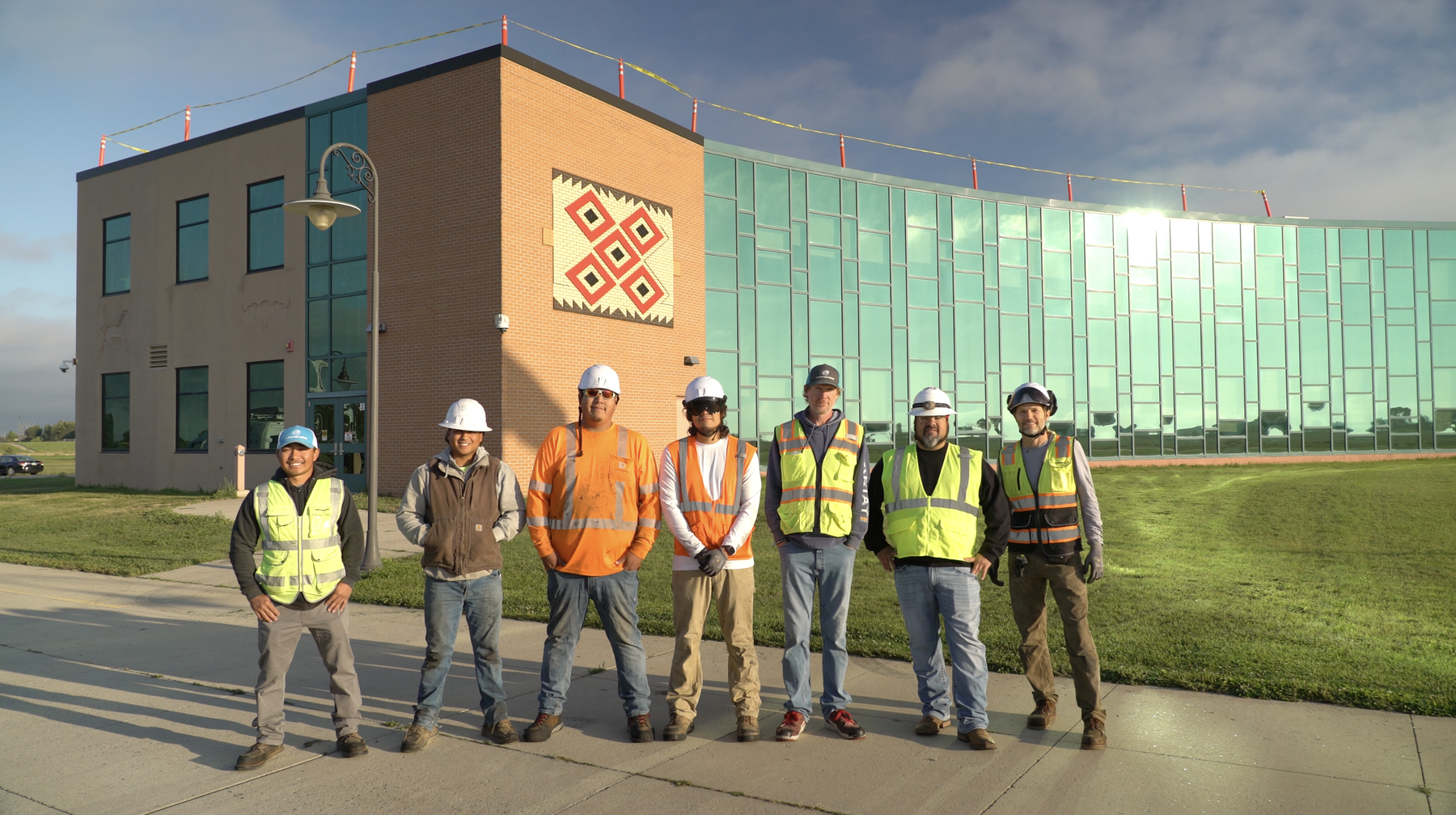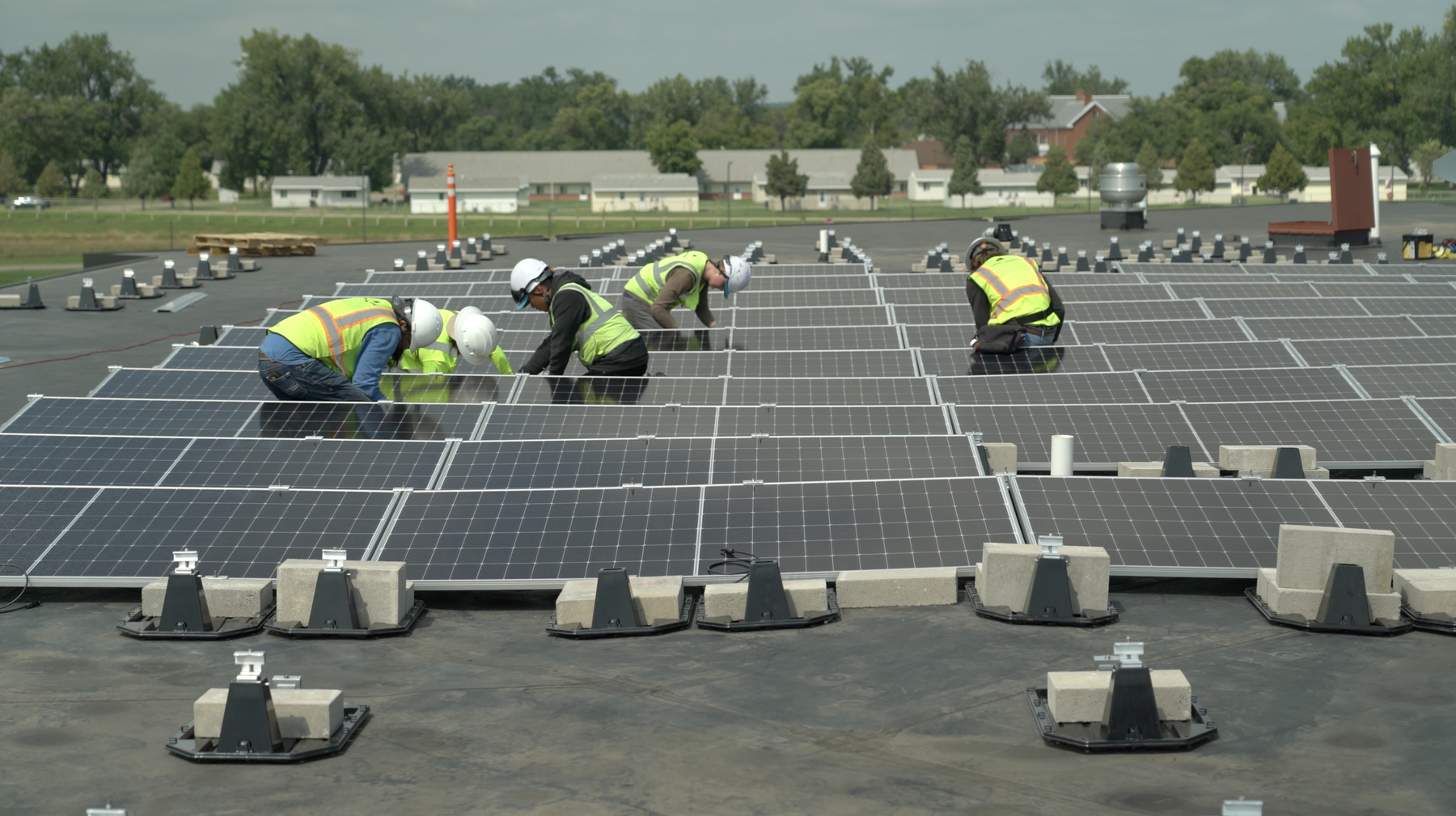
Four years ago, United Tribes Technical College in Bismarck, North Dakota, figured out that one small but mighty mobile solar unit can power a whole powwow—past midnight, if need be. Funded by a grant from the Tribal Solar Accelerator Fund, the installation got such a positive response from students seeking hands-on training that the college has continued to expand its solar program, part of a decades-long effort to create a net-zero campus. With additional grant funding from TSAF this year, the college installed solar panels to power its science and technology building and support its STEM curriculum.
The Native American-led TSAF works to expand renewable energy access for federally recognized tribes across the U.S. Launched in 2018 by GRID Alternatives, TSAF provides financial support, technical assistance, and workforce development to support solar energy projects. Tribal lands have had a long history of energy exploitation by extractive industries, including oil, gas, and coal. Locally controlled renewable energy offers tribes the opportunity to secure their energy resources, provide career opportunities for their communities, and reap long-term environmental and economic benefits.
TSAF works collaboratively with tribal leadership to identify the unique sustainability needs of each tribe, which are all culturally, geographically, and economically diverse, while centering deep-rooted traditions, principles, and lifeways, particularly around environmental stewardship. TSAF has partnerships with over 65 federally recognized tribes and has funded projects all across the U.S.
Waverley Street’s Priya Clemens spoke with Tanksi Clairmont, the Co-Executive Director of the National Tribal Program at GRID Alternatives, to learn more about TSAF’s work.
Priya Clemens: Why don't we start with you telling us about your role and how you came to this work?
Tanksi Clairmont: I've been with GRID for almost six years now. I was hired to conceptualize and develop the Tribal Solar Accelerator Fund back in 2018, and I got into this work maybe 10 years ago through some environmental sustainability work at the American Indian College Fund. I grew up in Denver, Colorado, but a lot of my relatives still reside on the Rosebud Sioux reservation and on the Sisseton-Wahpeton Dakota reservation, so I would visit with my family frequently. There's a lot of cultural teachings around land, water, the sun, and those were inherent in who I was as a Lakota person. As I got into this work, it seemed to unlock something in me that was kind of untapped.
Clemens: So tell me a little bit about how Tribal Solar Accelerator Fund works collaboratively with tribes to develop solar.
Clairmont: The way we work with tribes is fairly unique, because we are upholding cultural values. Because our team comes from the communities that we serve, we are upholding tribal sovereignty in a way that supports the inherent powers of these tribal nations that we work with.
Clemens: Let's talk a little bit about energy sovereignty. How do you define energy sovereignty, and how does solar support that?
Clairmont: The way I think of the components of tribal energy sovereignty, it really refers to the monetary or funding mechanisms that are used to support development and infrastructure. It refers to the cultural aspects of incorporating tribal values, principles, cultural lifeways, traditional values. It encompasses the environment and the ecological impacts that these new technologies may have. It encompasses even the technical aspects of the knowledge that needs to be shared when discussing and planning for renewable energy. Through our Tribal Solar Accelerator Fund and our National Tribal Program, we're not here to pressure tribal communities to develop solar energy. It's really that we're here and we do it in a way that respects their tribal sovereignty, and with that comes the ability to regulate and develop clean energy on their terms.
Clemens: I'd like to turn to the workforce development work that you're doing through some of your projects. Could you tell me about how your collaboration with United Tribes Technical College came into being?
Clairmont: They have been working toward establishing a net-zero campus for many, many years now, prior to me even getting into this work. Over the last 10 to 15 years, they've established an environmental sustainability degree program, and so they've been setting themselves up to really develop a clean energy future for their campus, as well as providing opportunities to their students in that degree program. We also need a number of other skilled trades to be trained in this industry—electricians and other folks who make renewable energy, particularly solar, happen.
It was about four years ago when we first received an application from the United Tribes Technical College—a $20,000 request to develop a mobile solar trailer. This trailer is used across campus as of today. It's used in the city of Bismarck to do educational training with K–12 schools. It's taken to different communities in the North Dakota area. We hadn’t funded something like this so it was really innovative. I think it was for the United Tribes International Powwow that happens in September every year. Powwows go through midnight sometimes. These arenas require a number of lights to energize the arena, so they used this mobile solar unit to do that.
They got such a good response from their students who wanted to have that hands-on training that they applied again for the latest round of grantmaking to provide solar on their science and technology building. This is just an example of one tribal college that is really leading the way in developing their energy future but doing it through solar.

Clemens: What inspires you to do the work you're doing?
Clairmont: I can look back and understand that six years ago, none of this [TSAF grants and programming] existed, and it happened pretty quickly. It just feels inspiring to be able to look back at your own work and see the impacts of that work and network with the folks who are now a part of the larger tribal energy ecosystem. It's also seeing the benefits that are happening in the tribal college space. Just exposing these opportunities to tribal communities or tribal people in general who may not have even thought about this as a possible career.
There are more and more Native women in the energy space. When I started attending different energy conferences, there weren't a whole lot of women. But over the last four years, I've seen a lot more women coming up in their roles as well. It’s really inspiring to know that you're a part of this larger movement that is going to take back some of the rights and some of the cultural connections to energy. I mean, the sun gives our Earth energy, and these are all embedded cultural knowledge and cultural practices.
It's important that we remain grounded in our cultural lifeways and the restorations of our tribal lands, because tribal communities are often on the forefront of climate change.
Tanksi Clairmont
Clemens: We talk at Waverley about our desire to have a world in balance and that right now we have a lot of broken relationships with nature. What does a world in balance look like for you in the work that you're doing?
Clairmont: Even in the last 20 years, when solar was more evident in larger cities, you didn't necessarily see solar or any kind of forms of renewable energy on or near tribal communities. It’s about shifting the powers in the climate change movement back to the ownership of tribal communities. It’s about dismantling those inequities in the energy space. And it's grounded and centered in environmental and social justice issues, and so it's important that we remain grounded in our cultural lifeways and the restorations of our tribal lands, because tribal communities are often on the forefront of climate change.
To learn more about our grantee partner, Tribal Solar Accelerator Fund, visit https://www.tribalalternatives


